|
|

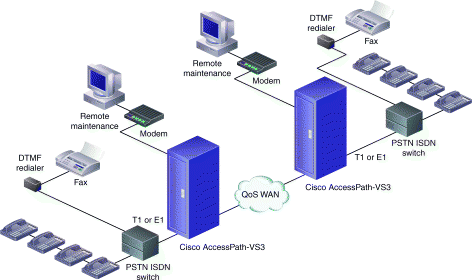
| Prepare Your Installation Site |
You must perform three logistical steps when unpacking and installing your Cisco AccessPath-VS3 Packet Telephony Concentrator:
1. Unload the crate from its shipping vehicle.
2. Move the crate using a forklift or similar device to the unpacking site.
3. Move the unpacked system to the installation site.
Consider the following issues before you unpack and install your system:
Cisco's seismic safety guidelines include bolting patterns that conform to Network Equipment Building Standards (NEBS) requirements.
To ensure seismic safety, you must anchor the cabinet to the floor as follows:
1. Drill 4 holes.
2. Insert casings (anchors) in the holes.
3. Secure the system to the anchors using threaded rods.
There are 3 possible bolting patterns:
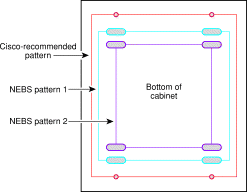
1
| Prepare Your Installation Site (continued) |
Cisco recommends the use of a bolting kit from HILTI, which has passed seismic testing when used with the Cisco AccessPath-VS3 system. If you use a bolting kit from another vendor (or if you supply your own), it is your responsibility to verify the fulfillment of seismic safety standards.
The recommended kit can be ordered by contacting HILTI, and includes the following elements:
In addition, you will use the load plate you saved when you unbolted the system from its shipping pallet.
Plan adequate human resources to unload and install the Cisco AccessPath-VS3 system. To safeguard both equipment and personnel during the installation process, Cisco recommends that five people be present whenever you move the cabinet.
A fully loaded system, with its casters installed for transport, can weigh up to 1300 lbs (590 kg), and moving it carelessly can endanger personnel.
Verify that you have the following tools available:
 | Warning Before installing the Cisco AccessPath-VS3 system, refer to the warnings listed in the document Regulatory Compliance and Safety Information for the Cisco AccessPath-VS3 Packet Telephony Concentrator. |
2
| Uncrate and Move the System |
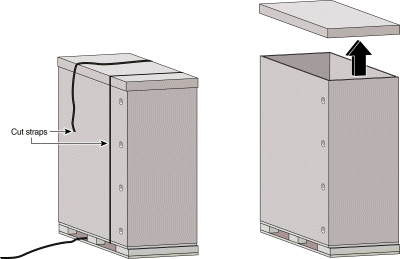
Perform the following steps to remove the system's cardboard packaging:
Step 2 Using a pair of tin snips, cut the 2 straps and discard them.
Step 3 Remove the top piece of cardboard and set it aside.
2
| Uncrate and Move the System (continued) |
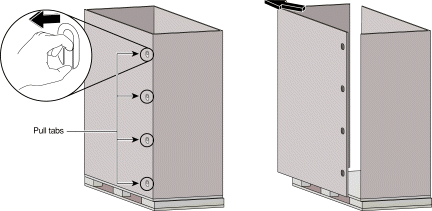
Step 4 Locate the 4 pull tabs that connect the 2 main pieces of corrugated wrapping. (Refer to the illustration above.)
Step 5 Go to the other side of the unit and repeat Step 4.
Step 6 Pull the large piece of cardboard away from the system, and store it in a safe place.
2
| Uncrate and Move the System (continued) |

A single piece of banding secures these kits to the pallet. Use tin snips to cut the banding. Remove the banding and lift the kits out of the cabinet.
System accessory kits include the following:
| Uncrate and Move the System (continued) |

Perform the following steps to remove the doors from their shipping positions:
1. Locate the banding strap that secures the doors to the side of the system.
2. Using tin snips, cut the banding while a second person holds the doors. Discard the banding straps and strap guides.
4. Set the door down against a nearby wall or carry it to the installation site. You will attach the doors to the system at the end of the installation procedure.
5. Lift the second door out of its retaining material and place it with the first door.
2
| Uncrate and Move the System (continued) |
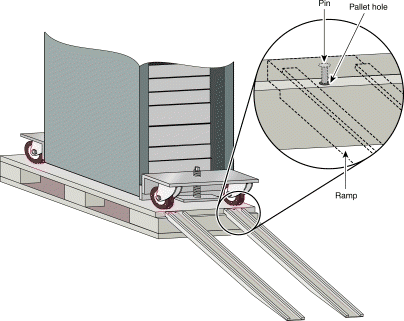
Perform the following steps to remove the ramp and attach it to the shipping pallet:
Step 2 Lift one of the ramp legs away from the system and walk to the front of the system.
Step 3 Locate the 2 pins that extend from the shipping pallet. Align the ramp leg so that the hole at its end is directly over one of the pins, and lower it until the peg fits securely into the hole in the wood. The first of the 2 ramp legs is now locked into position.
Step 4 Repeat Step 2 and Step 3 with the second ramp leg.
Step 5 Check again that the pins are secure and locked.
The ramp is ready for use.
2
| Uncrate and Move the System (continued) |
Perform the following steps to unbolt the unit:
Step 2 Using a standard 7/8-inch wrench, loosen the nuts that secure the bolts to the cabinet. Remove the nuts and set them aside.
Step 3 Remove and save the 2 x 3 inch (5.1 x 7.6 cm) load plates that sit beneath the nuts. (You will use these for seismic safety bolting.)
Step 4 Push the loosened bolts through the pallet so they fall to the floor.
Step 5 Repeat Step 1 through Step 4 for the remaining three bolts.
Step 6 Make sure that all 4 bolts drop completely through the pallet to the floor and do not obstruct the system.
3
| Uncrate and Move the System (continued) |
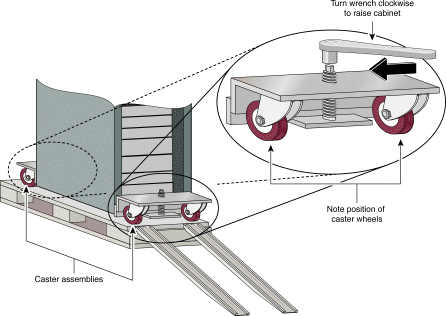
Have one person work the front caster assembly and one person the back assembly. Now raise the system:
Step 2 Turn the wrench clockwise to lower the casters and raise the cabinet. Each turn of the wrench will lower the caster assembly and raise the Cisco AccessPath-VS3 system.
 | Caution
You must raise the entire assembly 1 1/2 inches (3.8 centimeters) (the maximum possible) to ensure that the cabinet clears the ramp. Otherwise, the cabinet might catch on the ramp lip. |
Step 3 Continue to lower the front and back casters in a coordinated fashion until all 4 wheels barely touch the pallet surface. Do not allow the wheels to touch the surface.
Step 4 Align the front and back caster wheels using your hands until they are parallel with each other and face the attached ramp legs. Be sure that no one is turning the caster assembly as you align the wheels.
3
| Uncrate and Move the System (continued) |
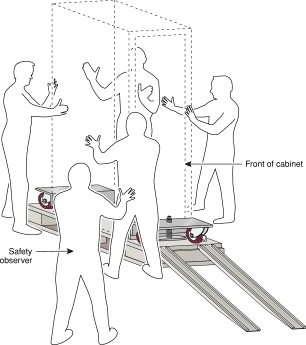
 | Warning We recommend that 4 people work together to roll the unit down the ramp and to the installation site. Using fewer than 3 people will substantially increase the risk to personnel and equipment. |
Step 5 Position yourself and the remaining personnel in the most efficient configuration. A fifth person should be present as a safety observer. If, as recommended, you have assigned 4 people to move the system, position each at a corner of the unit. If only 3 people are available, place 1 in front and 1 on each side.
Step 6 Roll the Cisco AccessPath-VS3 system down the ramp. Be sure to keep the unit under control, and move it as quickly as possible down the ramp.
| Uncrate and Move the System (continued) |
Step 7 After the system has reached the flat surface of the floor, roll it to the installation site. Check for any protrusions or obstacles that exist en route to the installation location. Walk quickly enough to maintain momentum, but not so quickly that you have difficulty turning or slowing the cabinet.
Step 8 After you have reached the installation site, move the cabinet into position over the bolt holes. See the "Install the Cabinet" section in Chapter 3 of the hardware installation guide.
| Install the System |
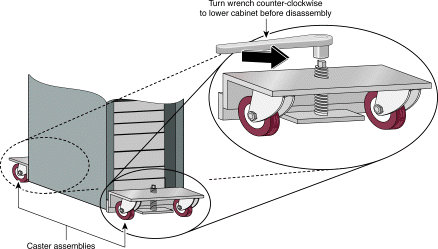
After moving the Cisco AccessPath-VS3 system to the installation site, you can install it by performing the following steps:
Step 2 If you have not yet placed the steel anchors into each hole, slide the cabinet away from the holes and do so now.
Step 3 Collect the 4 threaded rods that secure the system to the floor. Place them all within reach for easy access. (Each comes with a washer and a nut used to secure the rod within the casing. A load plate, also required to secure the rod, is shipped with the system packaging.)
Step 4 Locate the first mounting position on the base of the cabinet. Place the first thread loosely in the hole. Using a screwdriver, screw it down into the casing until it stops. Do not attempt to tighten the thread any further at this point.
Step 5 Repeat Step 4 for the remaining threaded rods.
4
| Install the System (continued) |

Step 6 Raise the casters to lower the system completely to the floor:
Step 7 Disassemble the caster assembly:
Step 8 Repeat Step 7 to disassemble the second caster assembly.
| Install the System (continued) |
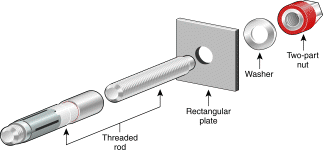
Step 9 Tighten down each of the threaded rods using a torque wrench.
 | Caution Because these nuts will shear when 60 ft-lbs are reached, you should use a box-end or 19 mm socket wrench until the top portion begins to shear. Be careful not to injure your hands and fingers during this process. |
5
| Install the System (continued) |
Although the Cisco AccessPath-VS3 system arrives precabled, you should check to make sure all the cables are connected and properly seated in their connectors.
The cable harness is the conduit by which the devices communicate with one another.
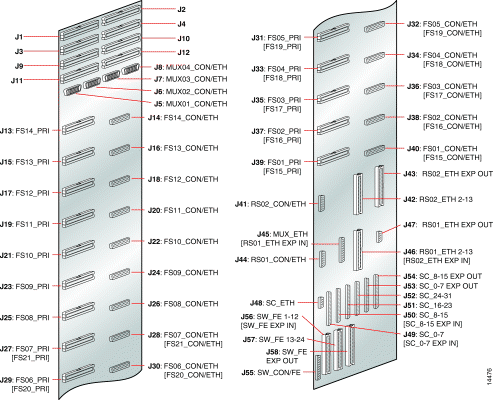
5
| Install the System (continued) |
| Step | Verify cabling to: | Cable | Should be connected from the shelf at: | To the signal harness at: |
|---|---|---|---|---|
1 | Patch panels | 72-1466-xx | J1-J4 | J2 (Patch panel 1) |
J5-J7 | J1 (Patch panel 1) | |||
2 | Access Server Shelves | 72-1464-xx | PRI 0-PRI 3 | Odd-numbered connectors, J13-J39 |
72-1463-xx | Console 0 Fast Ethernet 0 Ethernet 0 | Even-numbered connectors, J14-J40 | ||
3 | Gatekeepers (optional) | 72-1646-xx | GK_CON GK_ETH0 GK_ETH1 | J1 |
4 | Router Shelves
| 72-1462-xx | The 12 Ethernet switching ports in slots 5 and 6 | J46 (Router Shelf 1) |
72-1465-xx | Console 0 Ethernet 0 | J44 (Router Shelf 1) | ||
72-1489-xx | Router Shelf Fast Ethernet port 5/0 Router Shelf 1 Fast Ethernet port 3/0 | Router Shelf port 0/02 Router Shelf 1 port 0/02 | ||
72-1490-xx3 | Router Shelf 1 Fast Ethernet port 5/1 | Router Shelf 2 Fast Ethernet port 5/14 | ||
72-1487-xx1 | The 12 Ethernet switching ports in slots 3 and 4 | J56 | ||
5 | System Controller | 72-1461-xx | Async 0-7 Async 8-15 Async 16-23 Async 24-31 | J49 J51 J50 J52 |
72-1457-xx | Ethernet 0-1 | J48 | ||
6 | Switch Shelf | 72-1462-xx | The 24 Ethernet switching ports, Fast Ethernet 1-12 and 13-24 | J56 |
72-1486-xx | Console Ethernet (Fast Ethernet ports 1 and 2) | J55 |
5
| Install the System (continued) |
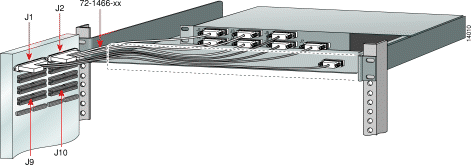 All configurations should look like this:
All configurations should look like this:
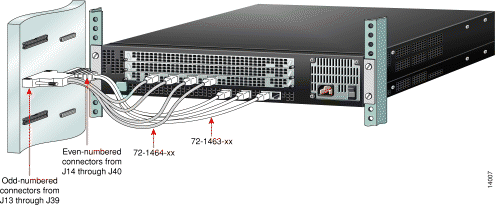 All configurations should look like this:
All configurations should look like this:
| Install the System (continued) |
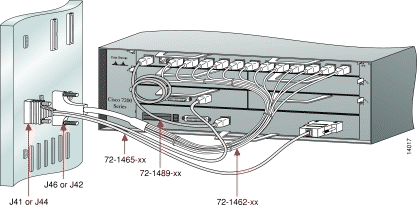 All configurations should look like this:
All configurations should look like this:
Additionally, for High-End configurations, you must verify the interconnect cables: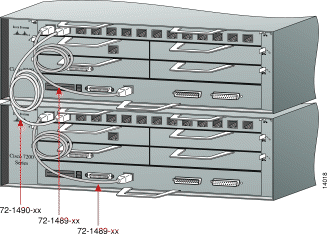

Install the System (continued)
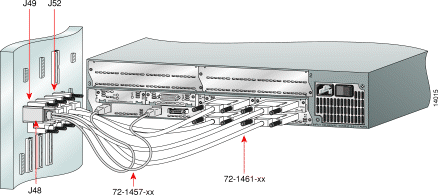 All configurations should look like this:
All configurations should look like this:
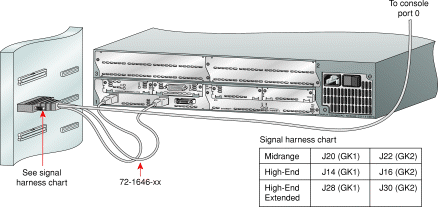 All configurations should look like this:
All configurations should look like this:
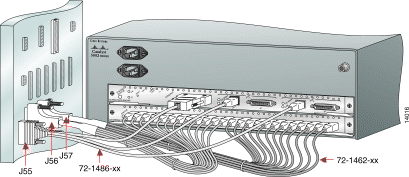 All configurations should look like this:
All configurations should look like this:
5
| Install the System (continued) |
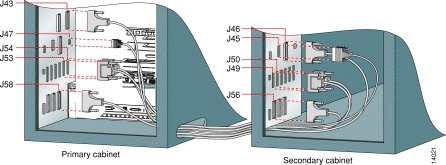
The Cisco AccessPath-VS3 system comes in 4 different configurations, the most advanced of which is the High-End Extended configuration. If you order the High-End Extended configuration, you must cable the devices in the secondary cabinet to those in the primary cabinet using 5 expansion cables. The maximum space between the cabinets is 30 feet (9.14 m).
| Step | Connect Cable Part Number | From the Primary Cabinet Signal Harness Location | To the Secondary Cabinet Signal Harness Location |
1 | 72-1459-xx | J43 | J46 |
2 | 72-1458-xx | J47 | J45 |
3 | 72-1460-xx | J53 | J49 |
4 | 72-1460-xx | J54 | J50 |
5 | 72-1459-xx | J58 | J56 |
5
| Install the System (continued) |

Perform the following steps to install the AC Out-of-Band Modem.
Step 2 Attach the power cable to the supplied extension cord, which converts a 2-pronged connector to a 3-pronged connector that fits the power strip.
Step 3 Insert the modem adapter (29-0881-xx) in the serial port at the back of the modem. Tighten the screws to secure the connection.
Step 4 Take the modem, velcro strap, and related installation components to the back of your Cisco AccessPath-VS3 system.
5
| Install the System (continued) |
Step 5 Locate the modem bracket found in the right rear corner of the system when viewed from the back. This bracket, which forms a metal pouch for easy modem installation, is premounted against the wall of the system.
Step 6 Position the modem above the metal pouch at the center of the bracket. Insert the modem so that the ports and modem adapter are at the top of the device.
Step 7 Take the velcro strap and loop it around the back of the modem and through the bridge lance that attaches to the outside of the installation pouch.
Step 8 Wrap the velcro tightly and press the strips together, securing the modem in the metal installation pouch.
Step 9 Attach the power cord to the modem port located at the top left edge of the installed modem. (If you have not connected the modem power cord to the supplied extension cord, do so now.)
Step 10 Attach the modem serial connector to the System Controller:
Step 11 Connect your external phone line. Insert one end of the line connector (RJ-45) into the line port and the second connector end into a wall jack.
Step 12 Turn the modem ON. You have now established out-of-band management to your system.
6
| Install the System (continued) |
To connect power to your system, you must first verify that your site meets the power requirements, which help guarantee power redundancy to the Router Shelf and the Switch Shelf:
For a Cisco AccessPath-VS3 system equipped for AC power, the power is supplied to the various shelves through a power strip located on the right side of the system, inside the front door.
Step 2 Verify that the AC power connections are firm between the shelves and the power strip. Check the connections in this order:
Step 3 Plug any unconnected power cords that come from the Cisco AccessPath-VS3 system into the power strip at the appropriate location.
Step 4 Connect each of the AC power input cables that bring power into the system power strip to a separate grounded power source. (This will require seven dedicated 20A (100-127 VAC) or 10A
(100-240 VAC) circuits per cabinet.)
Step 5 Turn each of the shelves ON, one at a time.
| Install the System (continued) |
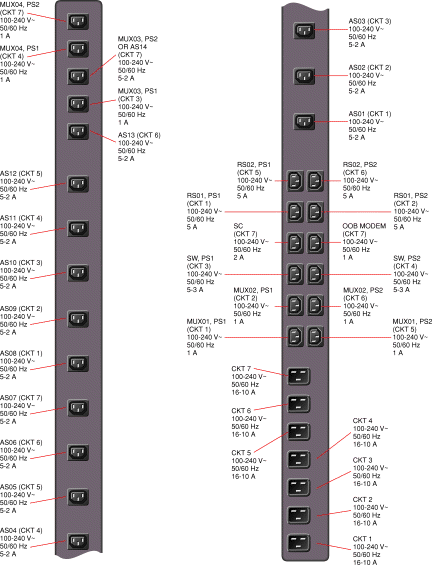 AC Power Strip
AC Power Strip
| Install the System (continued) |
For a Cisco AccessPath-VS3 system equipped for DC power, the power is supplied to the various shelves through a DC busbar. This busbar comes with the system and is installed in the system cabinet.
Check DC grounding and busbar connections in the following order, starting at the top of the rack:
Step 2 If you need to connect any of the shelves to the DC busbar, do so:
Step 3 Connect the main earthing wire to either set of double grounding studs using a 2 to 6 AWG copper stranded wire crimped to a double lug of the appropriate size. (These studs are located at the top and bottom of the rear of the system.)
Step 4 Remove the DC busbar inlet panel. Connect DC power to the DC busbar. This will require 4 dedicated 45A (-48 to -60 VDC) circuits per Cisco AccessPath-VS3 system cabinet.
With the DC power source turned OFF, connect a 2 to 6 AWG copper-stranded wire to the DC busbar using the provided double lugs and following these guidelines:
6
| Install the System (continued) |
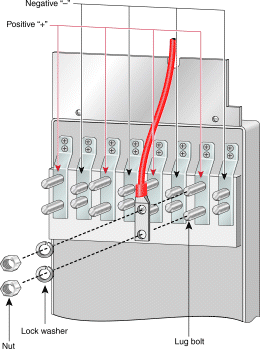
Step 5 Reduce possible strain on the DC electrical connection by installing the strain relief kit at the top of the cabinet:
Step 6 Tighten the nuts that connect the DC power feeds to the inlet.
6
| Install the System (continued) |
Step 7 Tighten the 5 screws on the strain relief kit so that they firmly grip the DC power feeds.

Step 8 Replace the DC inlet panel.
Step 9 Make sure that all of the shelves are turned OFF.
Step 10 Turn ON power at the DC power source.
Step 11 Turn each of the shelves ON, one at a time.
| Install the System (continued) |
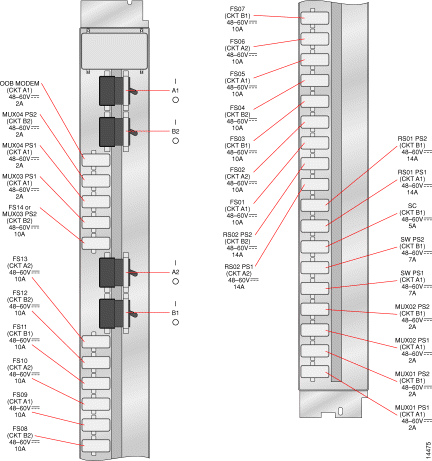 DC Busbar
DC Busbar
| Install the System (continued) |
You connect to a T1 or E1 network using patch panels, which either have RJ-48C connectors or posts for wire-wrap connections. The port mapping between the patch panel ports and the individual Access Server Shelves is the same for either wire-wrap or RJ-48C connections.
Perform the following steps to connect to the patch panel wire wrap connections:

Step 2 Use a wire-wrap tool to connect to the Receive Tip, Receive Ring, Transmit Tip, and Transmit Ring connections for up to 28 connections per patch panel.
Step 3 Replace the patch panel cover, routing the cables out the right side.
8
| Install the System (continued) |
Perform the following steps to connect your T1 or E1 network to the patch panel using RJ-48C connections:
Step 2 When you have connected the T1/E1 cables, route them to the right and tie-wrap them so that they do not obstruct other shelves.

Connect to your network backbone through port adapters on the Router Shelf as follows:
Depending on whether you will be connecting to a LAN or a WAN, your backhaul port adapters should be installed as follows:
After installing the correct port adapters, be sure to configure them properly. Refer to the documentation that shipped with your port adapter.

Install the System (continued)
![]()
![]()
![]()
![]()
![]()
![]()
![]()
![]()
Posted: Tue Jul 23 10:00:37 PDT 2002
All contents are Copyright © 1992--2002 Cisco Systems, Inc. All rights reserved.
Important Notices and Privacy Statement.